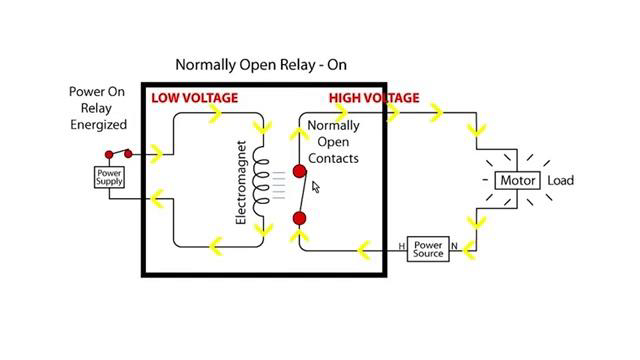Relays_Single_Throw_vs_Double_Throw.pdf
- All relays have a set of contacts, these contacts allow electricity to pass through them when they are in the closed position (or when they are touching each other)
- Depending on the function we need in a relay, we can use a NO contact or a normally closed contact.
Normally Open Contacts
- The contacts will not be touching each other in it’s normal state (that is when the coil is not acting on the contact)
- When the coil is energized, the normally open contact will be pulled against the other stationary contact into a closed state
- At this point, electricity will be able to pass through the contacts.
- A relay that is normally open is providing power when the coil is energized.
Normally Closed Contacts
- The contacts WILL be touching each other in the relay’s normal state (when the coil is not acting on the contacts)
- When the coil is energized, the contact will be pull away from the other stationary contact, thus opening the circuit.
- At this point electricity that was previously flowing when the contacts were closed, will no longer be flowing when the coil is energized.
- It is important to note that the contact side of a normally closed relay will be energized. So at any given point either the coil side or contact side will have power to it.
Double Throw Relay
- There are also relays that give us both options in the same relay. This is called a double throw relay
- Double throw relays have the ability to control two different circuits with the same relay.
- So a double throw relay will let us wire one circuit to the normally open side, and another circuit to the normally closed side.
- When the coil is energized the normally closed contact will open and the normally open side will close.
- They both use the same power, or common.
Transcript:
[0m:4s] Hi I'm Josh Bloom, welcome to another video in the RSP Supply education series. Today we want to talk to you a little bit more about relays. More specifically, the difference between single throw and double throw. Why does it matter and how does it affect the way we choose a relay? Depending on the function of a relay, we can choose either single throw or double throw. Let's start with single throw.
[0m:26s] When selecting a single throw relay, we have to choose between either normally open or normally closed contacts.
[0m:33s] So, as you can see here in a normally open contact, the contacts are not actually touching each other. When we apply power to the electromagnet,

[0m:42s] the contacts are closed allowing electricity to pass through the contact side of the relay.

[0m:47s] So, it is important to note that when we have power on the coil, we also have power on the contact side of the relay. When power is removed from the coil, the contacts open and we no longer have power passing through. So, now let's talk about a normally closed contact. So, with a normally closed relay, as you can see, with no power applied to the coil, we have power running through the contact side of the relay. So, when we apply energy to the coil,

[1m:14s] it opens the contact shutting off power to the contact side of the relay. So remember, with a single throw relay, we have the option between it normally open or normally closed relay. There are also relays that give us both options, both normally open and normally closed in the same relay. These are referred to as double throw relays. What's important to note about double throw relays is it gives us the ability to control two different circuits on the same relay. One thing to consider with the double throw relay is it can be used in place of a single throw relay by wiring only to the normally open or only to normally closed side of the relay.

[1m:51s] So, let's look at how a double throw relay actually works.
[1m:55s] In this scenario, we have the double throw relay wired to two separate circuits, as you can see here.
[2m:1s] So, the first thing to notice here is that the coil is not energized. You can see that we have power running through the normally closed side of the relay, however, we do not have power running through the normally open side of the relay.
[2m:14s] If we apply power to the coil, you can see that we now have power running through the normally open side of the relay. However, we have now lost power to the normally closed side of the relay.
[2m:26s] So, as you can see, there are many different examples whether you might want to use a single throw or a double throw relay. For a full line of relays or thousands of other products, please go to our website. For more information or other educational videos, go to RSPSupply.com, the Internet's top source for industrial hardware. Also, don't forget: like and subscribe.




